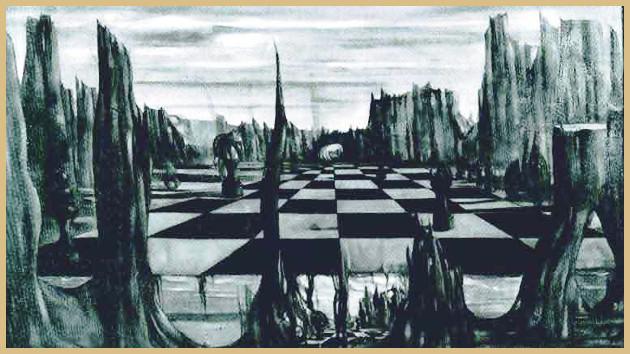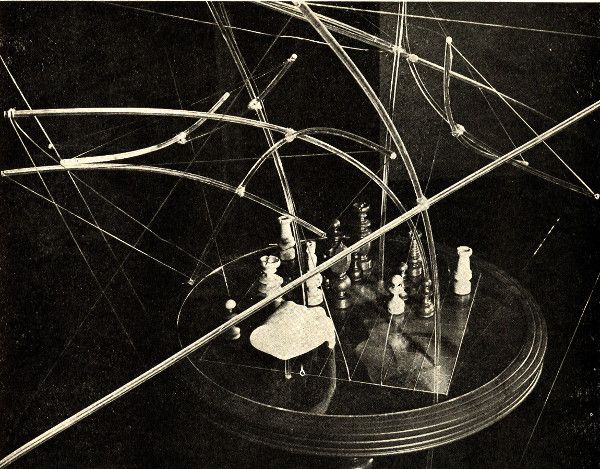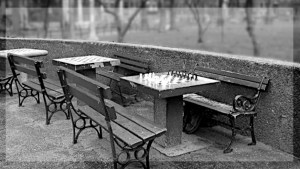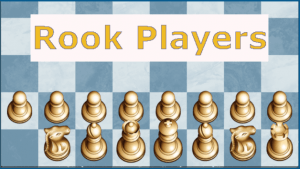
Blindfold Art
Convergences:
 Miles of String by Marcel Duchamp
Miles of String by Marcel Duchampfrom the "First Papers of Surrealism" exhibition New York 1942,
Photo by John Schiff hangs at the Philadelphia Museum of Art.

Untitled sculpture by Xanti Schawinsky for the "Imagery of Chess" show 1944-45
Dorothea Tanning called Schawinskiy a "chess whiz" in "Between Lives: An artist and Her World"

Convergence by Jackson Pollock 1952
Albright-Knox Art Gallery, Buffalo, NY
If we view existence as an eternal fabric and each life a strand in that fabric, during the length of that strand, other strands weave in and out, making threads. Occasionally when several threads converge at a certain point in time, something special happens. Examining the development leading up to such a convergence can be a fascinating endeavor.
* * * * * * * * * * * * * * * * * * * * * *
Julien and Marcel
When Julien Levy met Marcel Duchamp at Joseph Brummer's art gallery on 43 East Fifty-Seventh Street in Manhattan in 1927, history was made.
They hit it off magnificently and Duchamp invited Levy, who expressed a desire to learn about photography, to go with him to Paris to meet his close friend Man Ray. On this trip Levy also met his future wife, Joella Haweis, daughter of Mina Loy, the famous feminist poetess and prototypical Dadaist muse. During the cruise to Paris Duchamp taught Levy how to play chess, a most propitious occurrence. Levy, who was now working for Weyhe Gallery on Lexington Avenue, New York which handled modernist works of art and photography by emerging artists (whose works could be bought for a song), was impressed by the European Surrealists he had met overseas and decided to open his own gallery. The Levy Gallery opened on 602 Madison Avenue in 1931 with with an exhibition of the photographs of Alfred Stieglitz. On January 29, 1932 Julien arranged the first Surrealists exhibition in the city called "Surrealism Paintings, Drawings & Photographs" or simply "Surrealisme." This exhibition included works of Max Ernst, Pablo Picasso, Jean Cocteau, Joseph Cornell, Pierre Roy and Salador Dali (including the now famous "Persistence of Memory," a painting Levy had purchased in 1931 from the Pierre Colle Gallery for $25,000).
Marcel and George
Marcel Duchamp moved back to Europe in early 1923. At that time he was staying in Belgium and joined the Cercle le Cygne in Brussels of which Baron Forgeur was president and Edmond Lancel was vice-president. Later that year he took part in a inter-club tournament involving clubs in both Brussels and Antwerp. George Koltanowski had belonged to the Cercle d'Anvers but in 1923 he moved to the Jewish Cercle Maccabi.
The Maccabi won the club prize, followed in order by the Anvers, Le Cygne, Philidor, Bruxells, Gand, Mat ou Pat and Les Augustins.
The tournament also determined the Belgian Champion. Koltanowski won, followed by Edgard Colle, E. Sapira, Victor Soulanbeieff, Edmond Lancel, Edouard Verschueren and H. Horowitz.
Koltanowski beat Duchamp in their individual game (below).
[Duchamp lost a second game to Koltanowski in the Brussels championship tournaments but that game seems lost forever.]
[see: Les Cahiers du CREB -Championnats de Belgique d'Echecs (1901-2009)]

Duchamp and Koltanowski both participated in the 1st Chess Olympiad in Paris in 1924. The tournament coincided with the establishment of FIDE of which they were both a part. In the 1924 group photo above, Duchamp is standing in the top, far right while Koltanowski is sitting in second row, third from left (use the browsers "view image" for a full size rendition). Duchamp, playing for France did not encounter Koltanowski, playing for Belgium.
However, the two did play again under tournament conditions in the 1929 tournoi d'échecs at Paris. Saviely Tartakower won the tournament. Duchamp came in 9th out of the 12 combatants while Koltanowski tied with 2 others for last place. Adding to his poor performance, Koltanowski lost his single game with Duchamp in only 15 moves.
According to the San Francisco "Jewish Weekly," March 31, 2000
Koltanowski credits chess with saving his life. He was heading to Buenos Aires in 1940 for an international competition when his home country of Belgium was invaded by the Nazis. He found sanctuary first in Guatemala and later Cuba, where he caught the eye of a chess-playing American consul, who aided his immigration to the United States. Several family members died in the Holocaust.
While the "Bangor Daily News," July 27, 1979, gives Koltanowski's own words:Can you imagine it? I left Europe by boat on my way to Buenos Aires, Argentina, for the Chess Olympics. As Captain of the Belgium team, I was in my full glory, as I was going to give blindfold exhibitions in Canada, United States, Cuba, Guatemala and other Central and South American countries. That was in September, 1939.
It was a glorious feeling to step off the boat in Quebec and start my chess pilgrimage. My shows were very successful and after a couple of tournaments in both Havana and Santiago de Cuba, which were both won by me, I traveled by a United Fruit banana boat to Guatemala.
It was a wonderful trip that was soon marred when, upon reaching the high plateau on which Guatemala City is nestled. I found a telegram waiting for me. t read: 'Belgium has cancelled its participation in the Chess Olympics. Sorry.' It was signed by Weltjes, president of the Belgium Chess Federation. This telegram left me high and far from dry. All I can say is that it was a tough ordeal.
Duchamp was also affected by the war. Fleeing occupied France, he arrived in the United States in 1942. Reconnecting with Julien Levy, Duchamp set up an art studio on W. 14th St. and soon came upon a successful W. 36th st. diamond cutter named George Koltanowski. They, with three others, formed the informal Greenwich Village Chess Club. They also had a small business venture in which Koltanowski sold pocket chess sets created by Duchamp during his chess tours.

Duchamp's Pocket Chess Set

George Koltanowski, 1940
In 1944, Koltanowski and Duchamp played the following game, recorded in Koltanowki's "Chessnicdotes."
Koltanowski became a sensation after his highly publicized 34 board blindfold simul, scoring +24 =10, played on September 20, 1937 in Edinburgh.

Julien and Max
Levy, who had divorced Joella Haweis in 1942 and married Muriel Streeter, was sharing a rented beach house during the summer of 1944 with Muriel, Max Ernst, Dorothea Tanning and a horde of mosquitoes on Long Island in the hamlet of Great River. Ernst, a friend of Duchamps, had escaped from Vichy France after being in and out of detention camps including Les Milles, Saint-Nicolas and Largentière. He and many other artists and musicians were declared undesirables and creators of degenerate art and music (Entartete Kunst). Additionally, he was a German citizen, outspoken again the Nazi regime, and his first wife and current, though estranged, wife were both Jews. He fled to Marseilles where Varian Fry set him up with documentation and Peggy Guggenheim contributed financing that enabled his move to the U.S. where he arrived in 1941. There he met the aspiring painter Dorothea Tanning through Levy and fell in love her over a chess game. At the beach house Levy designed a portable "beach" chess set in which the pieces had rounded bottoms that could be pushed into the sand and played on a hand-inscribed board.
My Humpty-Dumpty chess set was for playing on the beach with round bottoms that could be pushed into the sand.... [we] drew the chessboard with our fingers. - "Memoir of an Art Gallery" by Julien Levy
This chess innovation, conceived with Ernst, was the seed for the fully bloomed idea of a Levy Gallery exhibition known to be known as "The Imagery of Chess."
* * * And here lies the CONVERGENCE * * *
The manifesto for the "Imagery of Chess" show, "On Designing Chessmen," asserted that traditional designs were visually unsuitable.
On Designing Chessmen
The standard chess sets now in use, the FRENCH Set and the STAUNTON, are both somewhat confusing in the similarity and intricacy of their forms. In the French Set for example, the Bishop is a little Queen and the pawn a little Bishop. Cannot a new set be designed, that is, without too radical a departure from the traditional figures, at once more harmonious and more agreeable to the touch and to the sight, and above all, more adequate to the role the figure has to play in the struggle? Thus, at any moment of the drama its optical aspect would represent (by the shape of the actors) a clear incisive image of its inner conflicts. In the complicated modern game the figures should inspire the player instead of confusing him. They should whisper to him at the right moment: "Move now to QB4....Break through the center....Pin the Knight....Let me win a piece....We can exchange Queens, the pawn will be metamorphosed into a new Queen....to mate the King."
and
they should never make a
MISTAKE.
Originally 32 artists, one for each piece on a chessboard, were selected but eventually several more joined in. While the original concept called for new designs in the chess accoutrements, the artists supplied sculptures, paintings, collages and kinetic pieces as well.
The show, which lasted from December 12, 1944 through January 31, 1945, was highly publicized in both art and secular media (a fact that actually turned art critics against it with the assumption it must be trivial).

Midway through the show —January 6, 1945— George Koltanowski gave a blindfold demonstration.
A blindfold exhibition fit nicely into Duchamp's conception that the chess board and pieces were a necessary, yet imperfect interface between the mind and the game. His desire to re-design the board and pieces was centered on the idea that the physical elements of chess should interfere as little as possible with the mental elements. A better design would suggest the correct movement by its visual aspects. Blindfold players don't use such a physical interface - a fact not at all lost on Duchamp.

Note that the program called for five games but lists six people— Alfred Barr, Jr., Max Ernst, Fredrick Kiesler, Julien Levy, Dorothea Tanning, Dr. Gregory Zilboorg.
The actual event involved seven players: Alfred Barr, Jr., Max Ernst, Frederick Kiesler, Julien Levy, Dorothea Tanning, Xanti Schawinsky and Vittorio Rieti.
On the wall of the blindfold exhibition room hung Kay Sage's "Near the Five Corners;" Carol Janeway's ceramic "Chess Set;" Matta's "6 Threats to a Wile Q;" one of Xenia Cage's wood and rice-paper mobiles suspended in the window; Duchamp's Pocket Chess Set with Rubber Glove;" and Leon Kelly's "The Plateau of Chess."
—"From Art to Performance" by Meredith Lancaster.

The caption in the photo above (from Between Lives: An artist and Her World
by Dorothea Tanning) mistakenly gives 1944 as the year of the blindfold exhibition.

Frederick Kiesler, George Koltanowski (facing away), Alfred Barr, Jr.
(playing on an Ernst strategic board with an Ernst set)

Duchamp, moving for Koltanowski (facing away);
Alfred Barr, Jr. using an Ernst set; Xanti Schawinsky using a Bauhaus set.

Another view of the chess room, although not during the blindfold exhibition.
Julien Levy plays Muriel Streeter Levy (background).
Max Ernst plays Dorothea Tanning (foreground).
On the evening of January 6th, blindfold master George Koltanowski gave an exhibition of his skill at the Levy Gallery. His teller, who called out the moves, was Marcel Duchamp - the artist who created a sensation many years ago by his "Nude Descending a Staircase."
Duchamp stopped painting when he took up chess and is now one of the leading spirits in the "art applied to chess" movement. Most of Koltanowski's seven opponents were the artists whose works hung on the walls or stood on pedestals in the exhibition room. The players were seated at boards on which four reproductions of the Max Ernst chess-men and other modern styles were arranged.
The blindfold champion surveyed the scene with interest, examined the peculiar pieces with which his opponents were to play, then declared with feeling: "This must be the first exhibition in which the blindfold player has the advantage."
—Chess Review (January 1945)
"There, one evening (January 6, 1945) in the Julien Levy Gallery a small invited public watched seven chessboards manned by seven intrepid players: Julien himself; Fredrick Kiesler, avant-garde architect and dreamer; Alfred Barr, the director of the Museum of Modern Art, Xanti Schawinsky, chess whiz; Vittorio Rieti, composer dear to Balanchine; Max Ernst; and me, Dorothea, all braced to take on blindfolded chess master George Koltanowski, Marcel Duchamp called out the moves. (For the record: everyone lost except Kiesler, who managed a draw.)"
—"Between Lives: An artist and Her World" by Dorothea Tanning. pp. 90-92






